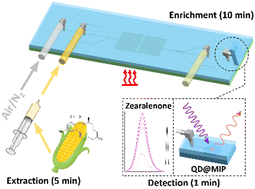Development of a microfluidic device to enrich and detect zearalenone in food using quantum dot-embedded molecularly imprinted polymers†
Abstract
Mycotoxins are secondary metabolites of certain moulds, prevalent in 60–80% of food crops and many processed products but challenging to eliminate. Consuming mycotoxin-contaminated food and feed can lead to various adverse effects on humans and livestock. Therefore, testing mycotoxin residue levels is critical to ensure food safety. Gold standard analytical methods rely on liquid chromatography coupled with optical detectors or mass spectrometers, which are high-cost with limited capacity. This study reported the successful development of a microfluidic “lab-on-a-chip” device to enrich and detect zearalenone in food samples based on the fluorescence quenching effect of quantum dots and selective affinity of molecularly imprinted polymers (MIPs). The dummy template and functional polymer were synthesized and characterized, and the detailed microfluidic chip design and optimization of the flow conditions in the enrichment module were discussed. The device achieved an enrichment factor of 9.6 (±0.5) in 10 min to quantify zearalenone spiked in food with high recoveries (91–105%) at 1–10 mg kg−1, covering the concerned residue levels in the regulations. Each sample-to-answer test took only 20 min, involving 3 min of manual operation and no advanced equipment. This microfluidic device was mostly reusable, with a replaceable detection module compatible with fluorescence measurement using a handheld fluorometer. To our best knowledge, the reported device was the first application of an MIP-based microfluidic sensor for detecting mycotoxin in real food samples, providing a novel, rapid, portable, and cost-effective tool for monitoring mycotoxin contamination for food safety and security.



 Please wait while we load your content...
Please wait while we load your content...